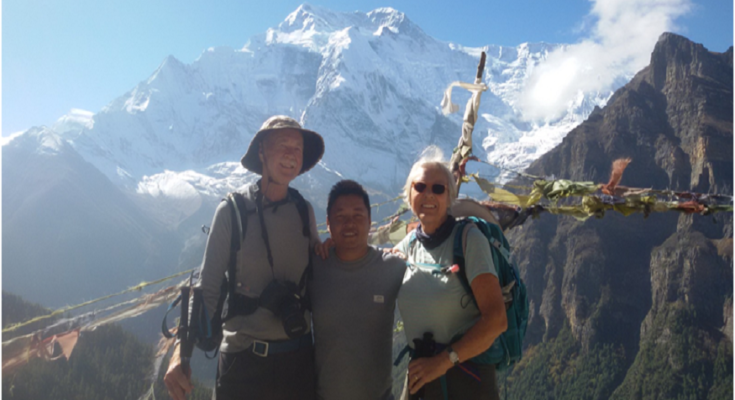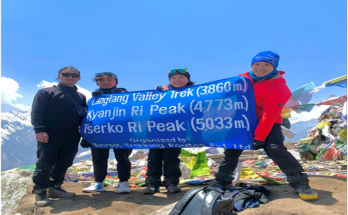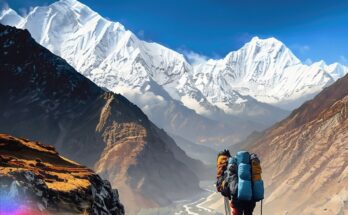Nepal is a place where the sky touches the mountains, and trails go deep into valleys where the time feels slow. Many go to the Everest side, some go to Annapurna, but not all know about some special treks that give the real and raw beauty of Nepal. Here, we talk about three treks: Pikey Peak Trek, Nar Phu Valley Trek, and Annapurna Circuit Trek. They show different faces of the Himalaya, from quiet hills to dry hidden valleys to big snowy passes. All three are very different but also somehow the same—they change how you see Nepal, and they stay in your heart.
Starting with Pikey Peak Trek—The Hill of Views
Pikey Peak Trek is not so long, but it feels big. It is in the lower Everest region, not very far but feels far. Not many go there, so it is quiet. You walk through green forests, pass small villages, and see big mountains without climbing too high. The trail is simple but full of surprises.
From day one, it feels peaceful. No big crowd. The local people smile and help. You stay in small teahouses, eat simple dal bhat, and hear stories of hills. The air smells like pine; sometimes you hear birds or cowbells.
When you reach Pikey Peak (around 4,065 meters), morning is best. Wake early, climb to the top, then wait. When the sun comes, it makes mountains golden. Some say it’s the best view of Everest without going to Everest Base Camp. And they might be right.
But Pikey Peak is not just about the view. It’s about walking slowly, meeting locals, feeling the wind, and knowing that even a short trek can touch your heart deeply.
Then the Wild One: Nar Phu Valley Trek
Nar Phu Valley trek is not like the rest of Nepal. It is dry and wild and feels like Tibet. Not many trekkers go here, since it needs an extraordinary permit and it’s a bit distant. But that’s why it’s extraordinary. You enter from the side of the Annapurna Circuit, but before long the path takes off the swarm behind.
You cross a contract canyon, climb soak stone ways, and enter a valley that feels misplaced in time. Nar and Phu are two ancient towns here, exceptionally ancient and full of convention. The houses are made of stone, individuals wear woolen dresses, and they live near to the arrival. They develop grain, raise yaks, and implore in ancient religious communities. Supplication banners fly, and the wind carries their wishes.
The trek takes you over 4,000 meters, and in some cases more. You pass tall bridges, solidified streams, and some of the time indeed snow in summer. But beauty is in the rawness. No shops, no luxury. Just nature and culture. This trek is not for those who want comfort, but for those who want connection.
You also see Kang La Pass if you continue—a high point over 5,300 meters. It is hard but beautiful. From there, you look back at the valleys and ahead to the Annapurna giants. The silence here is strong. You feel small but also full.
The Huge Circle: Annapurna Circuit Trek
If you need everything—rivers, timberlands, deserts, tall passes, enormous sees, and profound valleys—Annapurna Circuit trek gives it all. This trek has been popular for a long time, but it is still effective. Many roads now come close, but the heart of the trek is still beating strong.
You start from the green side, maybe Besishahar or Jagat. Some days you walk under waterfalls, other days under big cliffs. As you go higher, trees park, and land becomes dry. It feels like walking to another world.
Manang is a nice place to rest and adjust to high altitude. You can see Gangapurna Lake and maybe visit Ice Lake or monasteries. Then, the big climb started—Thorong La Pass, 5,416 meters. It is tough. Windy, cold, slow steps. But the top is like touching the sky.
After passing, you go down to Muktinath—a sacred place for both Hindus and Buddhists. You feel pleased, and the discussion gets hotter. At that point you can walk through the Bronco side or go to Jomsom and fly. A few keep strolling to Tatopani and Poon hill. It depends on time and legs.
Annapurna Circuit appears how Nepal changed—from wilderness to tall snow, from Hindu sanctuaries to Buddhist supplication wheels, from present day towns to yak herders. It is like a moving picture of Nepal.
What Makes These Treks Special Together?
Each trek is different. But when you do all three, you see Nepal in full. Pikey Peak shows peaceful hills and far mountains. Nar Phu shows a raw valley and old culture.
Pikey is soft but deep. Good for short treks and still feels big. Nar Phu is hidden and wild. You feel alone, but in a good way. The Annapurna Circuit is long but gives a full experience. Rivers, mountains, temples, and snow, all in one.
Doing these three, you understand not just mountains, but people too. You see how Sherpas live on the Pikey side. How Tibetan-style life goes on in Nar Phu. And how Gurung and Thakali people make life around Annapurna.
Food also changes. In Pikey, you eat millet bread; in Nar Phu, it’s tsampa and yak butter tea.In Annapurna you get everything—dal bhat, thukpa, and indeed apple pie in a few places.
Things to Know Some time recently You Go
Weather: The best seasons are spring (Walk to May) and harvest time (September to November).Winter is cold in Nar Phu and Annapurna Pass. Monsoon is not good—leeches and landslides.
Permit:
- Pikey needs no special permit.
- Nar Phu needs a restricted area permit, ACAP, and a guide.
- Annapurna Circuit needs TIMS + ACAP.
- Do paperwork before going.
Fitness:
- Pikey is moderate. Good for beginners.
- Nar Phu is tough. I need to be fit and ready for the cold and no comfort.
- The Annapurna Circuit is long and tiring. But you can plan it slowly.
Guides:
It’s a good idea to take a guide in Nar Phu. It helps with language, culture, and permitting. Pikey and Annapurna can do it solo, but a guide is always better for experience.
Final Thoughts—Three Trails, One Country, Many Faces
Nepal is more than just Everest. These three treks show you that. Pikey Peak shows calm beauty. Nar Phu Valley shows deep mystery. Annapurna Circuit shows full drama. Doing all three—not maybe at once, but one by one, or how you feel—will make you see Nepal differently than before.
You will remember the sound of wind on Pikey Top. You will remember the smiling child in Phu village. You will remember the sunrise after Thorong La. Trekking is not continuously approximately how tall you go, but how profound it goes inside you. And in Nepal, each step tells a story—of arrival, of individuals, of peace, of battle. Walk slowly, see more, and let these three treks change how you feel about the world.
Contact Details
Company address: Everest Trekking Routes Pvt. Ltd.
16 Khumbu, Nayabazaar, Kathmandu, Nepal
Mobile : +977-9843467921 (Rabin)
Email: [email protected]




